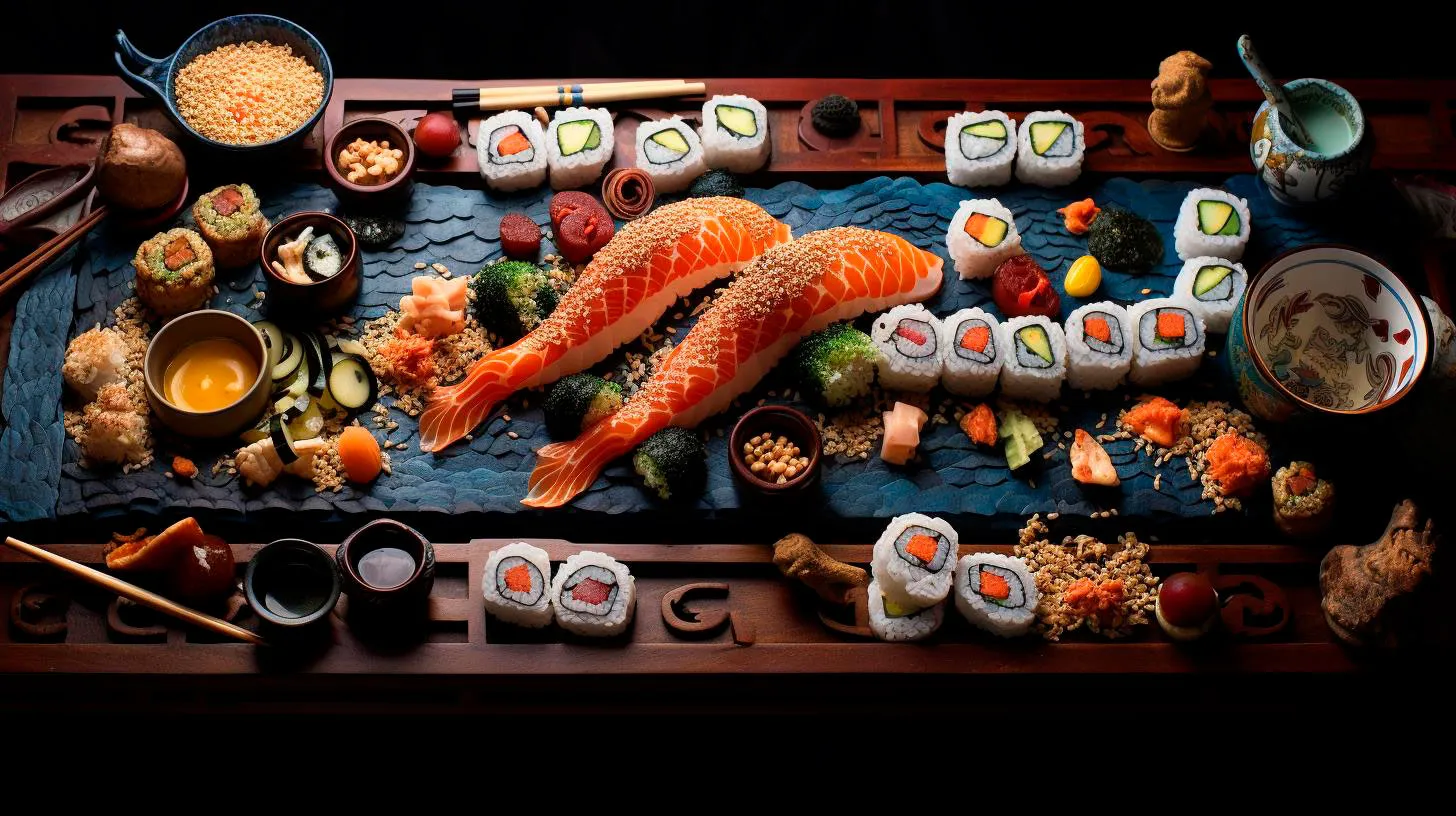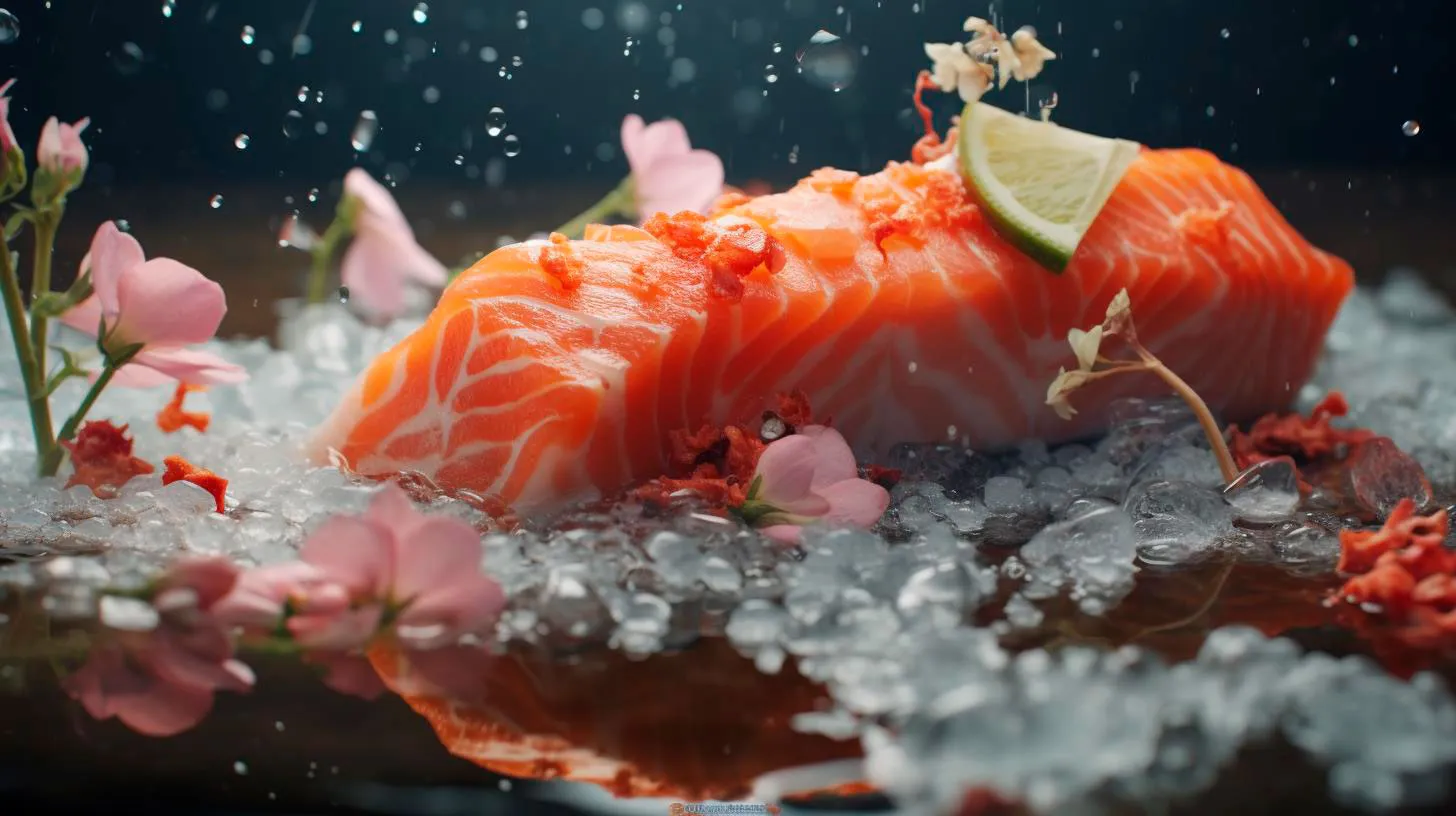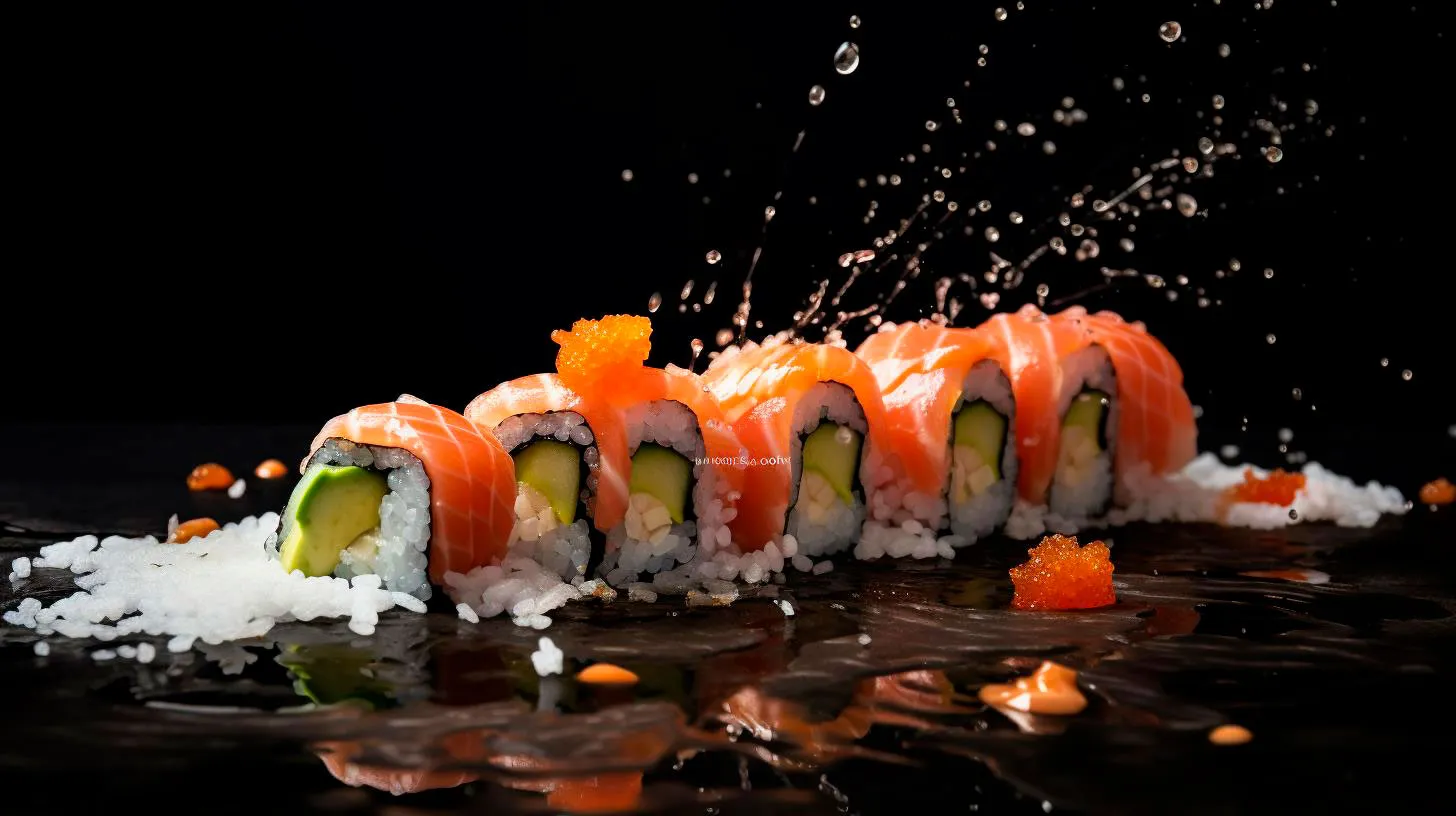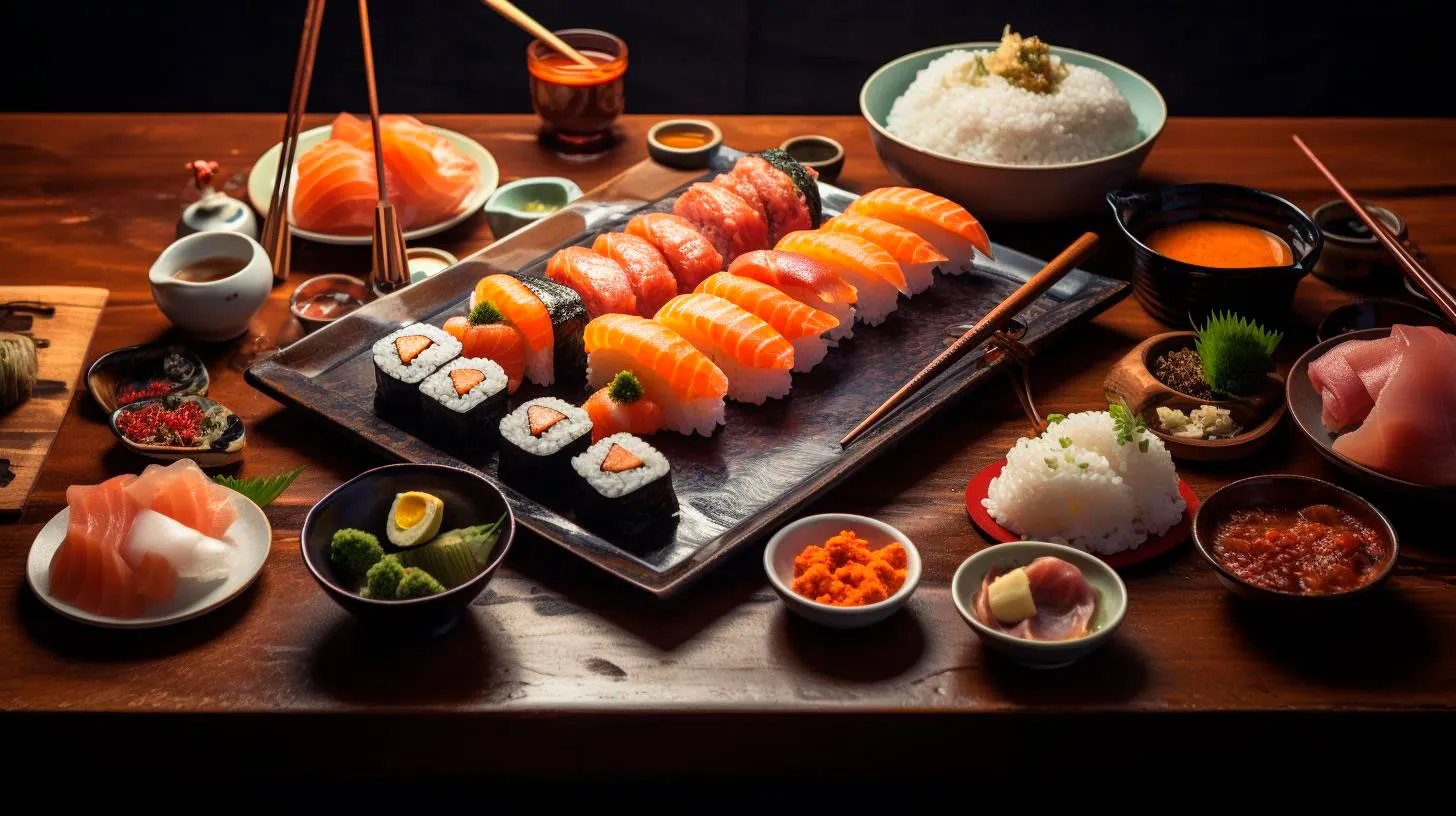Creating Culinary Masterpieces: A Feast for the Senses with Sushi
In this article, we will explore the art of sushi-making, its cultural significance, health benefits, and key considerations for creating your own culinary masterpieces.
The Art of Sushi
Sushi-making is considered a form of art in Japan. It requires precision, skill, and attention to detail. The artistry of sushi lies in its presentation and the harmonious blending of flavors. Each piece of sushi is carefully crafted, capturing the essence of Japanese culinary traditions.
- Beautiful presentation: Sushi is known for its visually stunning presentation. Chefs meticulously arrange the ingredients, creating an exquisite display of colors and textures. The use of fresh, high-quality ingredients further enhances the visual appeal.
- Flavor combinations: Sushi is a perfect balance of flavors. From the salty umami of soy sauce to the subtle sweetness of fresh fish, each bite offers a symphony of tastes. The combinations are endless, allowing chefs to experiment and create unique flavor profiles.
- Attention to detail: Sushi-making requires attention to detail at every step, from selecting the freshest ingredients to slicing the fish with precision. It is this attention to detail that sets sushi apart and makes it a true culinary masterpiece.
The Cultural Significance
Sushi is deeply rooted in Japanese culture and has a rich history dating back centuries. It is not just a meal but a cultural experience that reflects the values and traditions of the Japanese people. Here are some key insights into the cultural significance of sushi:
- Symbol of tradition: Sushi is a symbol of Japan’s culinary heritage. The techniques and recipes passed down through generations preserve the country’s traditions and showcase its unique gastronomy.
- Seasonal ingredients: Traditional sushi emphasizes the use of seasonal ingredients. This practice not only ensures the freshest flavors but also reflects the Japanese philosophy of living in harmony with nature.
- Social and communal: In Japan, sushi is often enjoyed in a communal setting. It brings people together, fostering social connections and a sense of togetherness.
Health Benefits of Sushi
Sushi is not only a delight for the senses but also a healthy food choice. Its ingredients offer a range of nutritional benefits that contribute to overall well-being. Here are some key health benefits of sushi:
- High in Omega-3 fatty acids: Sushi often includes fatty fish like salmon or tuna, which are rich in Omega-3 fatty acids. These healthy fats have been associated with a reduced risk of heart disease and improved brain function.
- Source of lean proteins: Fish, a primary ingredient in sushi, is a great source of lean proteins. Proteins are essential for muscle growth, tissue repair, and maintaining a healthy immune system.
- Low in calories: Sushi tends to be low in calories, especially when compared to other fast food options. It is a great choice for those who are conscious of their calorie intake but still want to enjoy a satisfying meal.
Creating Your Own Culinary Masterpieces
Now that we understand the art, culture, and health benefits of sushi, let’s dive into some key considerations for creating your own culinary masterpieces:
1. Quality ingredients:
Invest in fresh, high-quality ingredients. Look for a reputable fishmonger and select the freshest fish available. The quality of your ingredients will significantly impact the taste and presentation of your sushi.
2. Knife skills:
A sharp, precise knife is essential for sushi-making. Practice your knife skills to ensure clean and precise cuts. This will have a direct impact on the aesthetics of your sushi.
3. Variety of fillings:
Experiment with different fillings to create unique flavor combinations. Consider traditional options like fresh fish, cucumber, or avocado, but also venture into unconventional choices to add your own twist to the dish.
4. Proper rice preparation:
The rice is the foundation of sushi. Pay attention to the rice preparation process, ensuring the right texture and seasoning. Achieving the perfect balance of flavors in the rice will elevate the overall taste of your sushi.
5. Embrace creativity:
While respecting the traditional techniques, don’t be afraid to get creative with your sushi. Explore different shapes, arrangements, and plating styles to personalize your culinary creations.
Creating sushi is not just about the final product but also the journey of experiencing and embracing Japanese culture. With the right ingredients, techniques, and a dash of creativity, you can embark on a culinary adventure that satisfies both the senses and the taste buds. So roll up your sleeves, grab the freshest ingredients, and let your imagination soar as you create your own sushi masterpieces!
The Art of Sushi: Harmonizing Flavor, Texture, and Color
In this blog article, we will explore the intricacies of sushi-making and how chefs master the art of balance.
Understanding Flavor Profiles
Flavor is a key element when it comes to sushi. Every ingredient used must harmonize with one another, creating a balance that is pleasing to the palate. Some essential flavor profiles to consider in sushi-making include:
- Umami: The savory taste that enhances the overall flavor of sushi. It is often derived from ingredients such as soy sauce, miso paste, or bonito flakes.
- Sweetness: Adding a touch of sweetness to sushi can provide a delightful contrast. This can be achieved by incorporating ingredients like mirin, a sweet rice wine, or sweetened vinegar.
- Acidity: A tangy flavor can help cut through the richness of certain ingredients. Rice vinegar and vinegar-pickled vegetables are commonly used to introduce acidity.
- Spiciness: For those who enjoy a bit of heat, adding wasabi or chili peppers can provide a fiery kick to the sushi.
By carefully selecting and combining these flavor profiles, sushi chefs create a symphony of tastes that dance on the taste buds, leaving a lasting impression.
Exploring Texture
In addition to flavor, texture plays a crucial role in sushi. Different ingredients bring varying textures to the dish, providing a delightful mouthfeel. Here are some common textures found in sushi:
- Crunchy: Adding crispy elements like tempura flakes or cucumbers can give sushi a satisfying crunch.
- Soft: Ingredients such as avocado or thinly sliced fish melt in your mouth, providing a soft and smooth texture.
- Chewy: Octopus or squid, when skillfully prepared, offer a unique chewiness that adds depth to the overall experience.
- Tender: The tenderness of salmon or tuna can be a crowd-pleaser, leaving a buttery texture on the palate.
By carefully selecting a combination of ingredients with varying textures, sushi chefs create a symphony of sensations that elevate the dining experience.
The Importance of Color
Sushi is not only a treat for the taste buds but also an exquisite feast for the eyes. The vibrant colors of each ingredient play a vital role in creating a visually appealing dish. Vibrant colors stimulate appetite and make sushi more enticing. Some examples of colorful ingredients used in sushi include:
- Red: Tuna or salmon, with their bright red hues, add a burst of color to any sushi roll.
- Green: Avocado, cucumber, or shiso leaves contribute a refreshing green color that complements other vibrant ingredients.
- Orange: Carrots or tobiko (flying fish roe) add a pop of orange, creating visual contrast and enhancing the overall presentation.
- White: Rice is a staple ingredient in sushi, providing a neutral canvas that allows other vibrant colors to shine.
By artfully arranging these colorful ingredients, sushi chefs create visually stunning pieces of edible art that are a feast for the eyes as well as the taste buds.
Key Takeaways
- Harmonizing flavor, texture, and color is an essential skill in sushi-making.
- Understanding flavor profiles such as umami, sweetness, acidity, and spiciness is crucial.
- Texture variation, including crispy, soft, chewy, and tender, enhances the dining experience.
- Vibrant colors in sushi create an appetizing visual presentation.
- The art of sushi requires precision, skill, and an eye for aesthetics.
In conclusion, sushi is not just a dish but a form of edible art. Mastering the art of sushi-making requires an understanding of flavor profiles, texture variation, and the importance of vibrant colors. Whether you’re a sushi enthusiast or a curious foodie, appreciating the intricacies that go into each perfectly crafted sushi roll enhances the overall dining experience.
A Fusion of Taste and Aesthetics: Unleashing the Power of Color and Texture in Sushi
Beyond its tantalizing taste, sushi is an art form that harmoniously combines color, texture, and taste to create an unforgettable dining experience.
The Artistry of Sushi
Sushi masters consider every aspect of their creations, meticulously crafting each piece with the aim of delighting all the senses. From the vibrant colors to the diverse textures, every element is carefully selected and strategically placed to achieve aesthetic balance. The artistry of sushi lies in its ability to transform ordinary ingredients into captivating works of culinary art.
The Power of Color in Sushi
Color plays a crucial role in sushi, as it not only enhances its visual appeal but also serves as an indicator of freshness and quality. Here are some key takeaways on the power of color in sushi:
- The vibrant hues of fresh ingredients, such as the deep red of tuna or the bright orange of salmon, create a visually enticing display.
- Color contrast between different ingredients, such as the green of avocado against the pink of pickled ginger, adds depth and intrigue.
- Traditional sushi rolls, such as the California roll with its combination of avocado, crab, and cucumber, showcase a beautiful array of colors.
The Textural Symphony of Sushi
Texture is another essential element that elevates sushi from a mere dish to a culinary masterpiece. Here are some remarkable features and advantages of the textures you will encounter in sushi:
- The buttery smoothness of raw fish, like tuna or yellowtail, provides a melt-in-your-mouth sensation.
- The crunch of tempura flakes or cucumber slices adds a delightful contrast to the softness of the rice.
- The chewiness of seaweed wraps, known as nori, complements the tender fillings, creating a textural symphony with each bite.
The Health Benefits of Sushi
Sushi’s allure extends beyond its visual and gastronomic appeal. It is renowned for its health benefits, making it a popular choice for health-conscious individuals. Here are some key reasons why sushi can be a nutritious addition to your diet:
- Fish, a primary ingredient in sushi, is an excellent source of omega-3 fatty acids, which promote heart health and reduce the risk of chronic diseases.
- Seaweed, a staple in sushi, is rich in minerals like iodine, calcium, and iron, boosting thyroid function and supporting bone health.
- Sushi often incorporates vegetables like avocado and cucumber, providing additional vitamins, fiber, and antioxidants.
Embracing Sushi’s Fusion of Taste and Aesthetics
Sushi is not just a meal; it is an experience that transports you to the heart of Japanese culture. The fusion of taste and aesthetics makes sushi a multifaceted delight for all the senses. Whether you are an avid foodie or a culinary adventurer, exploring the world of sushi is an opportunity to appreciate the mastery behind every roll.
Next time you savor a piece of sushi, take a moment to marvel at the artistry on your plate. Notice the vibrant colors that entice your eyes, the textures that dance on your palate, and the health benefits that nourish your body. Sushi is more than a feast for the taste buds; it is a celebration of the beauty found in culinary craftsmanship.
Indulge in the exquisite world of sushi and let its fusion of taste and aesthetics take you on a sensory journey unlike any other.
Unveiling Sushi Palette: Exploring the Role of Color and Texture in Flavor
Join us on this journey as we uncover the secrets behind the sushi palette.
The Vibrant Color Palette of Sushi
One cannot help but marvel at the visually stunning presentation of sushi. The vibrant hues of red, green, and orange are skillfully arranged to create a feast for the eyes. But did you know that the colors of sushi can actually influence the perception of taste? Research shows that colors can evoke certain emotions and affect our sensory experiences. Here are some key takeaways regarding the role of color in sushi:
- Color psychology plays a significant role in our perception of taste. For instance, vibrant red tones commonly associated with tuna may create a sense of excitement and intensity.
- Color contrast within a sushi roll can enhance the overall dining experience. Complementing colors like green and orange can create a visually appealing dish.
- Experimenting with different colors can allow sushi chefs to evoke specific moods or themes in their creations.
Texture: The Silent Hero in Sushi
While color catches our attention, texture is the unsung hero that truly elevates the sushi experience. Each bite is a combination of flavors and delightful textures that dance on our taste buds. Let’s explore the significance of texture in sushi:
- The ever-popular combination of soft, melt-in-your-mouth fish and crunchy vegetables creates an exquisite contrast that adds excitement to each bite.
- The use of varying textures, such as chewy seaweed, tender fish, and crispy tempura, adds layers of complexity to the overall flavor profile.
- Textural surprises, like hidden fillings or crispy tempura bits, can provide a delightful crunch that surprises and delights the palate.
Unleashing the Full Flavor Potential
Color and texture are not mere aesthetics in the world of sushi; they are essential elements that enhance the overall flavor experience. By understanding the connection between color, texture, and flavor, sushi chefs can create memorable dishes that captivate both the eyes and the taste buds. Here are some key insights to ponder:
- The perfect balance of colors and textures can heighten the sensory experience and make each sushi roll a unique masterpiece.
- Combining complementary flavors with visually appealing hues can create a harmonious journey of taste and aesthetics.
- Understanding the preferences of diners and experimenting with different color and texture combinations can lead to the creation of signature dishes that keep customers coming back for more.
In Summary
Unveiling the secrets behind the sushi palette reveals an intricate relationship between color, texture, and flavor. The vibrant colors awaken our senses, while the varied textures create an unforgettable culinary experience. To fully appreciate the mastery of sushi, one must embrace the artful fusion of visual aesthetics and mouthwatering flavors. So, the next time you savor a piece of sushi, take a moment to appreciate the intricate dance of color and texture that awaits you.



